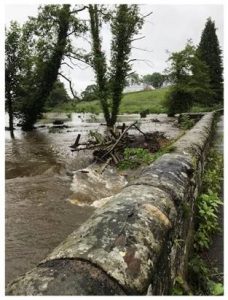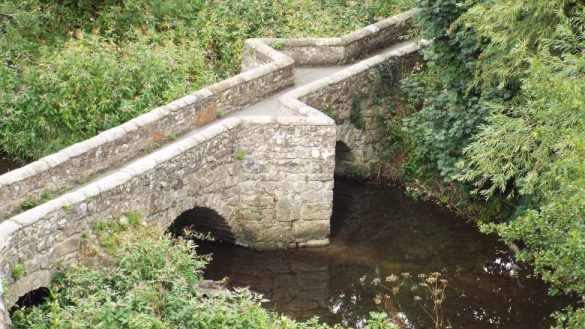David Healey is quietly optimistic about the future of the much-loved Packhorse Bridge near Caergwrle.
Caergwrle’s Packhorse Bridge is probably the oldest bridge to span the River Alyn and one of the finest examples of its type in Wales.
Medieval Times

Packhorse bridges were generally of narrow construction. The Caergwrle example contains triangular recesses in the parapet walls designed to allow pedestrians to move out of the way of packhorse trains crossing the bridge. The low parapets allowed, if necessary, the passage of bulging packs slung on each side of mules and packhorses. The illustration by Anne Robinson is extremely useful in helping us to visualise this traditional scene.
A bridge to link Caergwrle village and the Parish Church of Hope has almost certainly existed since medieval times. Presumably of timber construction, the bridge was clearly in a dilapidated state in 1654. It was then when Squire Ellis Yonge of Bryn Iorcyn Manor petitioned Flintshire Quarter Sessions to repair “Pont Caergwrley”. Yonge seems to have been the driving force behind moves to construct a new one from stone.
Local legend is that when the Parish refused to join with Yonge in financing the project, he went ahead on his own. He ordered the bridge to be narrow so that only his horse and pedestrians could pass.
The Spiteful Squire

Serious historians discount the “spiteful Squire” story. The construction of the bridge was probably a joint venture between the Lord of the Manor and the Parish. It made a seven-arched connection between Hope and Caergwrle. The bridge also served to link Chester to the Ffrith Packhorse Bridge, which crosses the River Cegidog. Remote parts of North Wales, as far afield as Corwen, gained direct access to the region’s most important market centre.
Severe flooding wreaked havoc across Britain in November 2000 and destroyed part of it. In 2001, the bridge received a new lease of life at an estimated cost of £100,000, with the cost split between Welsh Government and Flintshire County Council. It has come desperately close to being washed away again twice: first during storms in 2019 and more recently during the savage Storm Christoph that caused such damage in January 2021.
Ironically, the expense public authorities incurred in 2000 could have been unnecessary had the pleas of a newspaper correspondent not gone unnoticed many years ago. On 25th May 1956, the Wrexham Leader carried an article drawing attention to the silting up of the seven arches.
It stated: “So much so that even the tops of the arches are no longer visible”. The article went on to argue that young trees were sprouting from the ancient masonry and expressed the fear that heavy floor water would damage the weakened structure of the bridge”. The Parish Council urged Flintshire County Council and Dee Conservancy Council to carry out the necessary repairs, but it seemed to little avail.
We hope you’re enjoying this article about the Packhorse Bridge Near Caergwrle. Please click here for more stories about Wrexham’s rich and varied history.
Blocked Arches Causing Havoc

Half a century later, the prophetic words of the correspondent came true. The blocked arches could not cope with the worst floods in living memory and the whole structure became a dam. By checking the river’s flow, the bridge ended up forcing thousands of gallons of water across the floodplain and into nearby homes. Neighbouring residents only received relief from flooding when the bridge’s weakened masonry finally gave way, releasing the surging torrent to tear into the downstream banks of the Alyn. The all-too-obvious result was extensive further flooding. Successive authorities had failed to heed the early warnings and subsequently had to foot the bill.
The bridge then received further damage in 2015, when, on successive summer evenings, vandals removed the lime mortar from between the coping stones and pushed the stones into the river beneath. With the bridge under attack, Flintshire’s Streetscene acted swiftly to repair the damage. They also went the extra mile on that occasion by clearing out the archways of fallen trees and silt, which could cause a potential blockage. Their heroic efforts probably saved part of the community from flooding during the severe winter that followed. Without doubt, it was a star performance, applauded by those who lived close to the river.
Storm Christoph

In 2019, locals actually waded into the River Alyn to cut up and clear some trees that had washed against the bridge arches. Their deeds were particularly timely. Soon after they finished, subsequent winter storms caused floodwater to reach the parapet of the bridge.
Two years later, Storm Christoph struck and, with the arches clear, there was no debris to cause a blockage. Locally, there was a feeling that this storm was even worse than that of the year 2000. The River Alyn bust its banks in Hope, making a pedestrian route across the Sarn impassable. The flooding closed the A541 and the up-to-the step water levels caused anxiety and sleeplessness for several local residents. And, thanks to the efforts of the residents, the Packhorse Bridge survived.
People say there is sunshine after the rain and we have at least one piece of excellent news in the aftermath of Storm Christoph. The Packhorse Bridge had avoided its previous fate of November 2000 by a hair’s breadth. Faced with the new reality of recurring storms, Flintshire County Council has now made an unequivocal commitment towards the bridge. It is to be part of the highway and the Council has promised to maintain it. It is now up to local people to be vigilant and ensure the Council remains true to its word.
BBC Countryfile

As a long-term strategy, the water flowing into the River Alyn needs to lessen and cause numerous problems further downstream. What was barely tolerable has become a serious problem with climate change and heavier rainfall. It is fascinating to see some of the solutions that BBC Countryfile report from various parts of Britain. They include upland woodlands as a flood defence and the strategic planting of Sphagnum Moss to retain water in upland areas. The creation of shallow scrapes and ditches to retain water and enhance biodiversity on flood plains are other examples. Finally, the construction of reservoirs with sluice gates to store water for release later provides another answer.
Numerous tributaries feed the River Alyn from its source in the Clwydian Hills to its outlet into the River Dee. Climate change demands radical options to reduce the volume of water flowing into rivers and so badly affecting downstream communities.
We hope you enjoyed this article about the Packhorse Bridge Near Caergwrle. Please click here for more stories about Wrexham’s rich and varied history.

